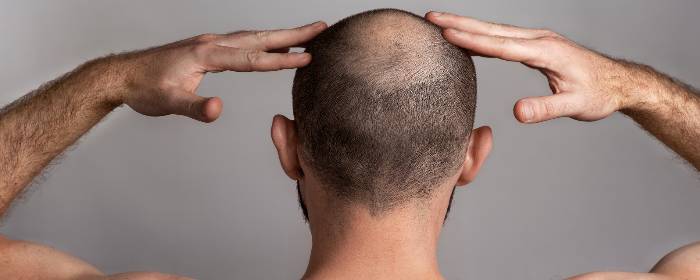Androgenetic alopecia is the medical term for pattern baldness. Pattern baldness can manifest in several ways such as a receding hairline, a bald spot in the crown of the head, and/or generalized thinning hair. Pattern baldness is the most common form of hair loss. Approximately 4 out of 5 men will experience some degree of androgenetic alopecia by the time they reach age 70. Androgenetic alopecia affects a substantial number of women as well. Pattern baldness is not lethal, but it can create substantial amounts of psychological suffering and greatly diminishes the quality of life for both men and women.
The two first-line treatments for androgenetic alopecia in men are finasteride or minoxidil. Finasteride is an oral medication, while minoxidil is topical, i.e. it is placed on this directly on the scalp. These baldness treatments are modestly effective in a certain percentage of men. Patients may also be treated with dutasteride, light therapy, platelet-rich therapy, or surgery. Minoxidil is the main form of treatment for women with androgenetic alopecia. If minoxidil fails to help regrow hair or stop the balding process, women may alternate treatments including spironolactone, finasteride, cyproterone acetate, or flutamide. As with male pattern baldness, female pattern baldness is somewhat resistant to treatment, leaving most women to cover their baldness with wigs or concealers.
One important observation about androgenetic alopecia is that while the number of hair follicle stem cells remains the same in people who are balding, the number of more actively proliferating progenitor cells drops dramatically. In other words, it is theoretically possible to treat androgenetic alopecia with hair follicle stem cells that contain actively proliferating progenitor cells.
Indeed, researchers recently tested this hypothesis in a group of 11 patients with androgenetic alopecia. The researchers collected a bit of tissue from each patient and then purified the sample to collect hair follicle stem cells with actively proliferating progenitor cells. The doctors then injected those stem cells into balding areas on the patients’ scalps. For comparison, some were treated with a placebo injection, i.e. saltwater.
Patients treated with hair follicle stem cells enjoyed a 29% increase in hair density over the treated area. by contrast. Patients treated with placebo had less than a 1% increase in her density over the same time period. The researchers also noticed that they were substantially more stem cells in and around hair follicles in balding areas.
The authors of this research concluded that isolated cells are capable of improving hair density in patients with androgenetic alopecia. While additional, larger studies are needed to confirm these results, the current study provides strong evidence that bald and balding patients may benefit from autologous stem cell treatment.
Reference: Gentile P. et al. (2017). Stem cells from human hair follicles: first mechanical isolation for immediate autologous clinical use in androgenetic alopecia and hair loss. Stem Cell Investigation. 2017 Jun 27;4:58.


 St. Petersburg, Florida
St. Petersburg, Florida
